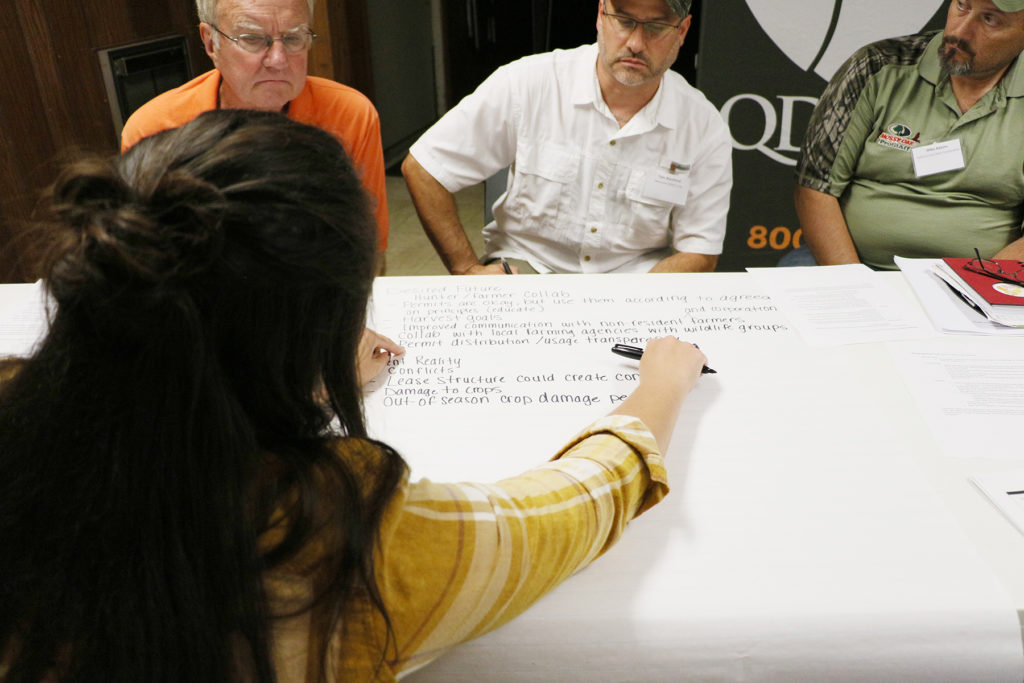
In the Field: Cooperative Communication Part 1
A wildlife cooperative is formed with the understanding that one’s ability to build and maintain relationships is key. Today we are going back to the basics and deciphering what it means to be a conscious communicator. In today’s world, communication is affected by both human communication (actual person to person exchange) and electronically mediated (phones, computers, etc.). Cooperatives face the challenge of having to engage with both forms cultural differences. Hunters come in all ages and genders…so how do we ensure that we are effectively reaching our target audience?
Let’s start with defining business and professional communication. I have chosen to use this definition based on what cooperatives are trying to accomplish. It is important to present information in an organized and professional manner while also speaking the language of your audience. Sometimes that might be just to hunters while other times you may have people that would more easily fall under the category of conservationists. However, don’t let that be confused with the fact that all hunters ARE conservationists but all conservationists are not hunters.
Business and professional communication is defined as a “shorthand term that refers to all forms of speaking, listening, relating, writing, and responding…” (Goodall, Jr., Goodall and Schiefelbein).
It’s easy to get caught up in trying to get a message across and forget the other aspects of communication. Without listening and relating to a subject’s point of view, how can you respond properly? This is where the significance of conscious communication comes in and can be broken down into four components.
Conscious communication is mindful.
This means that as a communicator, you take the needs and expectations of others into consideration. Think about how all cooperative members may have different goals. Your job as a leader is to shape group goals in a way that benefits everyone but most importantly the big picture, landscape level management.
“Mindful communicators recognize that while it is important to use strategic communication to reach goals, it is equally important to reach business and professional goals ethically” (Goodall, Jr., Goodall and Schiefelbein).
Instead of manipulating your message to fit what you want to see happen as a result of cooperative wildlife management, make sure you are using everyone’s input to put an effective plan in place.
Conscious communication displays awareness of communication as a process.
A common mistake people make is forgetting that what they say now can affect what happens later. There is a difference between making a statement and making a point, but sometimes points have to be broken down.
When we talk about information in terms of a cooperative, many times potential members are unfamiliar with what they are and how they function. There are always questions about what is expected from members and what rules exist if there any. As a leader, being aware of what information is being presented, in what way and when are all important parts of the process.
Note – what you say now must not be forgotten or contradict what you say in the future. This means having a well thought out plan to present your interest in expanding or forming a wildlife cooperative. Does this add some formality? Sure. Does it add organization and meaningfulness? Absolutely.
Conscious communication respects diversity.
The book I am referencing focuses on the workplace. But should we not still consider these factors from the perspective of hunter interaction? An effective communicator will have done research in order to properly respond to most (and I say most because we can’t possibly know it all and there is always room to grow) differing opinions with respect.
Another thing to consider when addressing your audience is that you don’t know what other potential cooperative members have in terms of resources. Make sure that introductory conversations don’t make people feel like they have to make large financial or time commitments. Their investment in the group will most likely grow as they form relationships within the cooperative.
Being a part of a cooperative doesn’t mean you have to agree on everything, but it does mean that you should have a healthy respect for each other, the land and how it’s managed.
Conscious communication requires being strategic.
When working through a process you should have your end goal in mind. This goal may change as a group progresses and adjustments can be made accordingly. Strategic communication is communication planned with specific audiences and specific intentions in mind, so spend time thinking about how to get there and not just why you want to.
Improving hunting and protecting our heritage is on everyone’s mind right now. We may not all go about doing it the same way, but organizations have continued to provide us with vital information to continue the upward climb. To engage in conscious communication use this four-step process: choose, create, coordinate, and deliver (CCCD).
CHOOSE a communication strategy
CREATE your message
COORDINATE the communication event
DELIVER the message
By following this communication strategy you put yourself on a path to successfully dictate the future of your cooperative. Stay tuned for next week’s blog on choosing a communication goal.
Reference:
Goodall, H. Lloyd., et al. Business and Professional Communication in the Global Workplace.
Wadsworth Cengage Learning, 2010.
